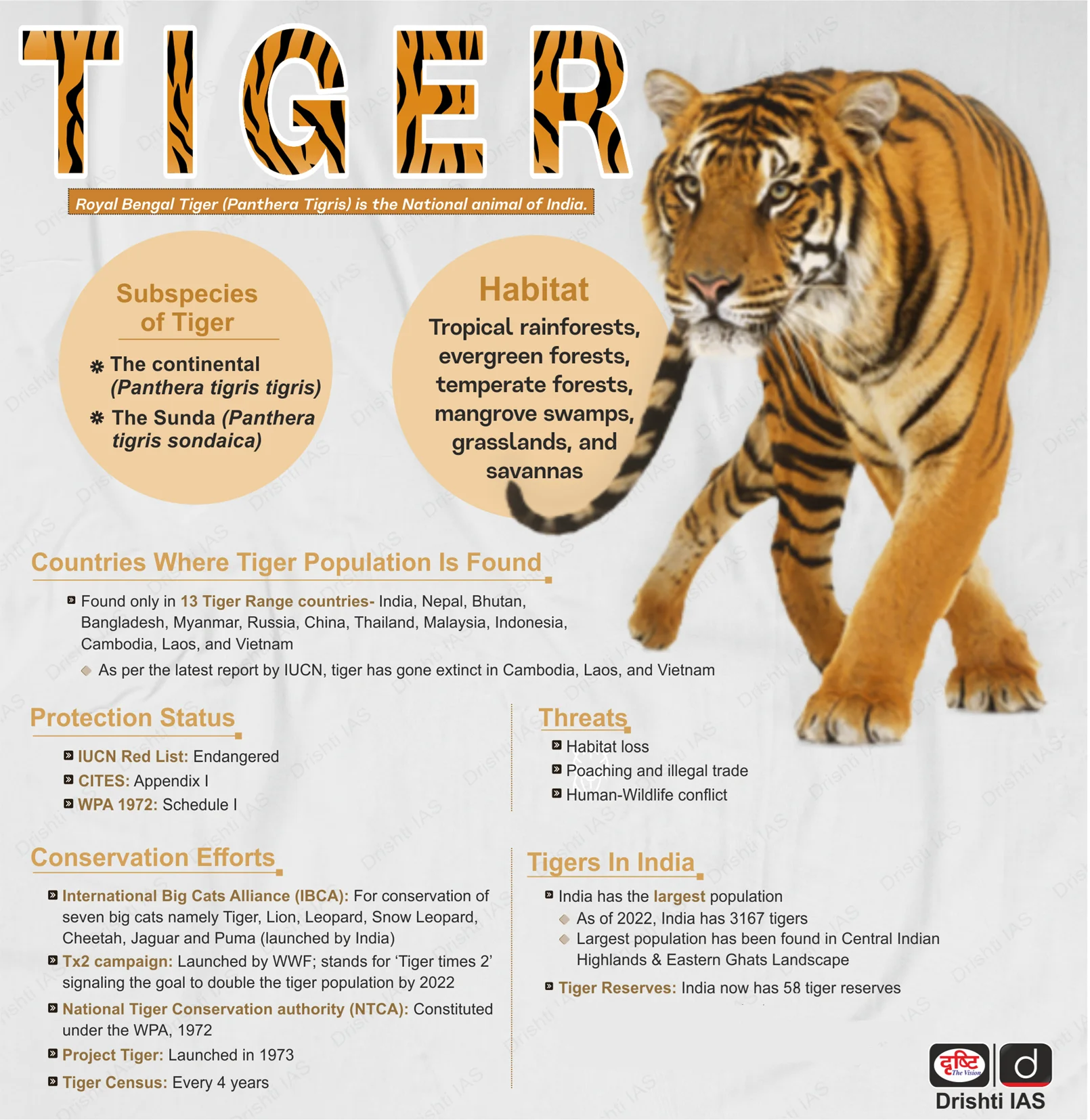Important Facts For Prelims
International Tiger Day 2025
- 29 Jul 2025
- 6 min read
Why in News?
International Tiger Day (also known as Global Tiger Day) on 29th July raises awareness about tiger (Panthera tigris) conservation and also highlights the Amur tiger (Panthera tigris altaica), the world’s largest wild cat.
History of International Tiger Day
- Global Tiger Day was instituted at the 2010 Saint Petersburg Tiger Summit, Russia where 13 tiger-range countries, including India, Bhutan, Nepal, Malaysia, and Bangladesh came together in response to the sharp decline in tiger populations.
- The summit launched the Tx2 initiative, aiming to double the wild tiger population by 2022.
How has India Contributed to the Conservation of Tigers?
- Need for Conservation: In the early 1900s, India had around 1 lakh tigers. By 1972, the number had dropped sharply to just 1,827.
- Alarmed by this, India launched Project Tiger in 1973 to protect Bengal tigers (Panthera tigris tigris) and their habitats.
Project Tiger
- About: It is a Centrally Sponsored Scheme, provides 60% Central Assistance to most states for non-recurring expenses and 50% for recurring costs, with states matching the rest.
- Primary Aim: Ensure a viable population of Bengal tigers in natural habitats.
- Key Steps Taken: Establishment of tiger reserves with a core-buffer strategy to protect habitats in core zones while allowing sustainable human activities in buffer zones.
- The National Tiger Conservation Authority (NTCA) set up under the Wildlife Protection Act, 1972, oversees Project Tiger and conducts the national tiger census every four years (last census done in 2022).
- Progress: Launched in 1973 with 9 reserves, Project Tiger now covers over 50 reserves across 18 states, spanning about 2.2% of India’s land.
- Tiger numbers rose from 1,827 in 1973 to an estimated 3,682 (avg) with an upper limit of 3,925 as per 2022 data.
- Madhya Pradesh has the largest tiger population, followed by Karnataka, Uttarakhand, and Maharashtra.
- Reserves with the highest tiger numbers are Corbett (Uttarakhand), Bandipur (Karnataka), Nagarhole (Karnataka), and Bandhavgarh (Madhya Pradesh).
- Nagarjunsagar-Srisailam Tiger Reserve (Andhra Pradesh) is the largest tiger reserve in India
- India now hosts around 75% of the world’s tiger population. The population has more than doubled in the last two decades, with a growth rate of 6.1% per year.
- The Project Tiger and Project Elephant Scheme has been merged from FY 2023-24 and is now known as Project Tiger & Elephant.
- Tiger numbers rose from 1,827 in 1973 to an estimated 3,682 (avg) with an upper limit of 3,925 as per 2022 data.
- Iconic Figures:
- Machhli (T-16) a famous tigress from Ranthambore, often called the 'Queen Mother of Tigers' and 'Tigress Queen of Ranthambore.' She became the poster face of Project Tiger.
- Kailash Sankhala, known as the Tiger Man of India, was the first director of Project Tiger.
- Cultural Significance: The Royal Bengal Tiger is India’s national animal and is deeply rooted in Indian mythology and pride.
Amur Tiger
- The Amur tiger, or Siberian tiger is the largest tiger subspecies and the biggest wild cat on Earth.
- Native to Russia’s Far East, it's adapted to harsh winters with thick fur and body fat. Solitary and territorial, it preys on wild boar, deer, and sometimes bears. It faces threats like poaching and habitat loss.
- In the Russian Far East, indigenous groups like the Udeghe, Nanai, and Oroch spiritually revere the Amur tiger, seeing it as a forest guardian.
- This mirrors tiger-linked beliefs in South Asia, like Bon Bibi in the Sundarbans.
UPSC Civil Services Examination, Previous Year Questions (PYQs)
Prelims
Q. Among the following Tiger Reserves, which one has the largest area under “Critical Tiger Habitat”? (2020)
(a) Corbett
(b) Ranthambore
(c) Nagarjunasagar-Srisailam
(d) Sundarbans
Ans: (c)
Q. Consider the following protected areas: (2012)
- Bandipur
- Bhitarkanika
- Manas
- Sunderbans
Which of the above are declared Tiger Reserves?
(a) 1 and 2 only
(b) 1, 3 and 4 only
(c) 2, 3 and 4 only
(d) 1, 2, 3 and 4
Ans: (b)








